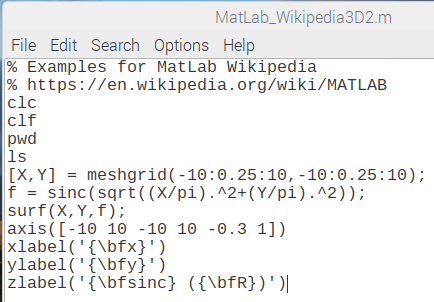

Let our signal work in the frequency band 0…100Hz and has a maximum amplitude of 1 Volt. To do this, it is necessary to determine the change in the signal speed during sampling Ts. Now let’s choose the value of maneuvering noise. As the initial value of the state vector ‘x’, we take zero values: Implementation of our Example To implement the example, it is necessary to set or calculate the system parameters.
Gnu octave programming examples update#
The separation of the Filter into two stages: “Prediction – Update after Next Measurement“ is important in control systems, since in this case it is possible to achieve a greater margin of stability. Calculation of the output values of the Kalman filter:.The structure of the discrete Kalman filter is shown in Figure 5-1:įigure 5-1: Structure of the Kalman Filter Next I will give the Kalman filter algorithm without proof. Kalman Filter Knowing the System Dynamic Model (6)/(14) and the measurement channel (8)/(16), it is possible to construct a Kalman filter that minimizes the error (11) of the ‘x’ state estimation. Let’s rewrite this formula in matrix form (8):ĥ. We measure the value of our signal, but our measurement is subject to noise: Model of the data measurement Measurement model is described (8): The signal speed can be changed and this change can be represented as noise (plant maneuvering noise):įormulas (12) and (13) can be rewritten in matrix form (6):Ĥ. Any signal can be described by the current value and the rate of signal change: Let’s go straight to my simple practical example. System Dynamic Model The System Dynamic Model is described using the formula (6): Next I will describe the theory of Kalman Filter and immediately apply it to my practical example, which can be used in many applicationsģ.Here I will give an example of a matrix variant C Implementation Using the Octave GNU Tool” an example of a simple scalar Kalman Filter was considered. In the previous article “Simple Scalar Kalman Filter.measurement of noisy parameters ‘y’, after which the prediction correction x(+) is carried outįigure 2-1: Kalman Filter: Prediction – Update States Notes:.extrapolation (prediction) of the next state of the system x(-) based on the system model.The Kalman filter minimizes the square of the estimation error (10): The filter works in two stages: Since the measurement/calculation is performed over a vector, the equations also have a matrix form. Kalman proposed an optimal recurrent algorithm for estimating system parameters. We make inaccurate (with error) measurements of some noisy signals ‘y’, knowing which, we can calculate the value of the state vector of the system. Introduction Suppose there is a dynamic system (6) for which the state vector ‘x’ is defined, for example, the position of the object, its speed, acceleration and so on. %This function takes in 2 inputs (x,y) and returns 1 output ĭydx = -2 * x^3 + 12 * x^2 - 20 * x + 8.Kalman Filter with Example. %This function takes in 3 inputs (x,y,h) and returns 2 outputs %This function takes in 4 inputs (x,y,h,xend) and returns 2 outputs That is why the 'Derivs.m' script shows dydx to be this particular polynomial. For main.m: %prompt userįor Integrator.m: function Integrator(x,y,h,xend)ĭydx = -2 * x^3 + 12 * x^2 - 20 * x + 8.5 Įdit 2: I shoud mention that the differential equation which Chapra and Canale have given as an example is:

I would be very grateful if you could get this program to work for me. I have to press 'Ctrl + C' in order to break execution.Įrror: 'ynew' undefined near line 5 column 21
Gnu octave programming examples code#
I tried implementing this code in GNU Octave, but depending on the input values, I am getting one of two errors: In it, they've provided pseudocode for the implementation of Euler's method (for solving ordinary differential equations). I am reading "Numerical Methods for Engineers" by Chapra and Canale.


 0 kommentar(er)
0 kommentar(er)
